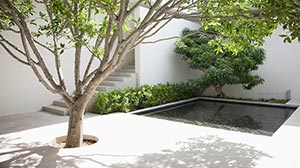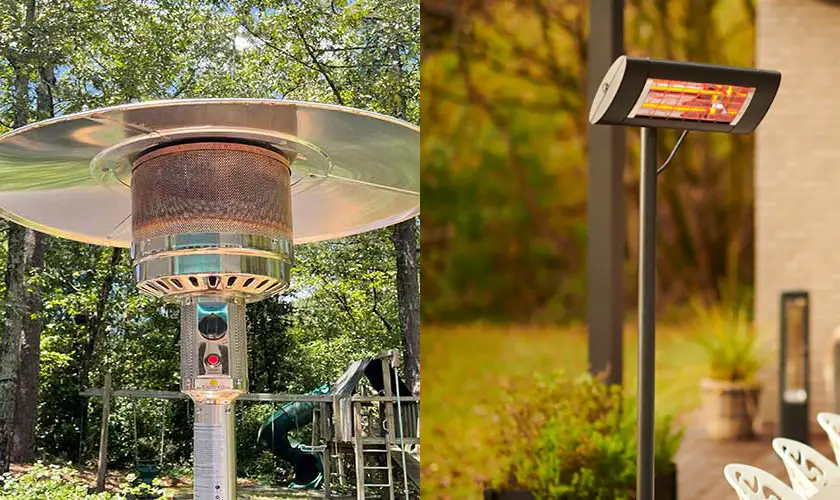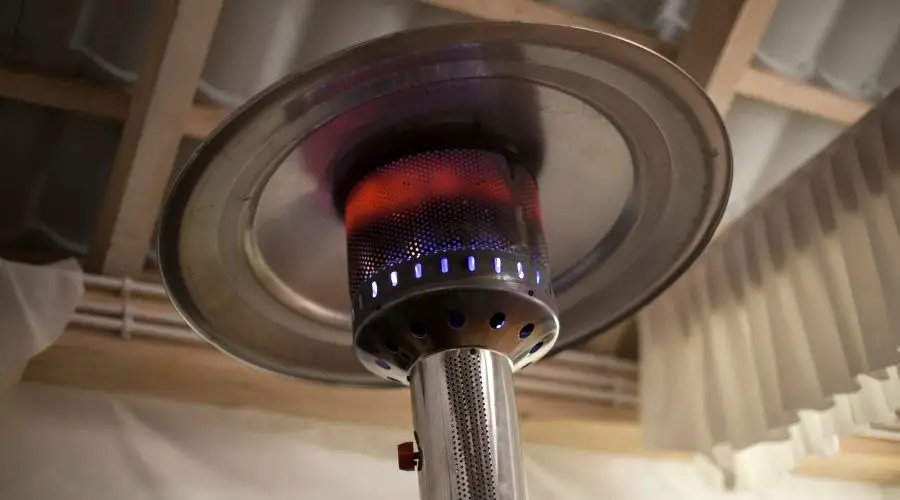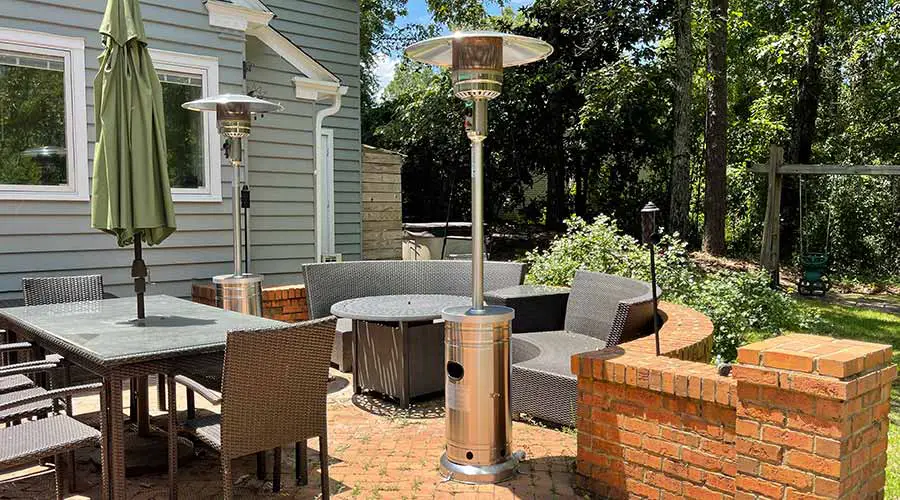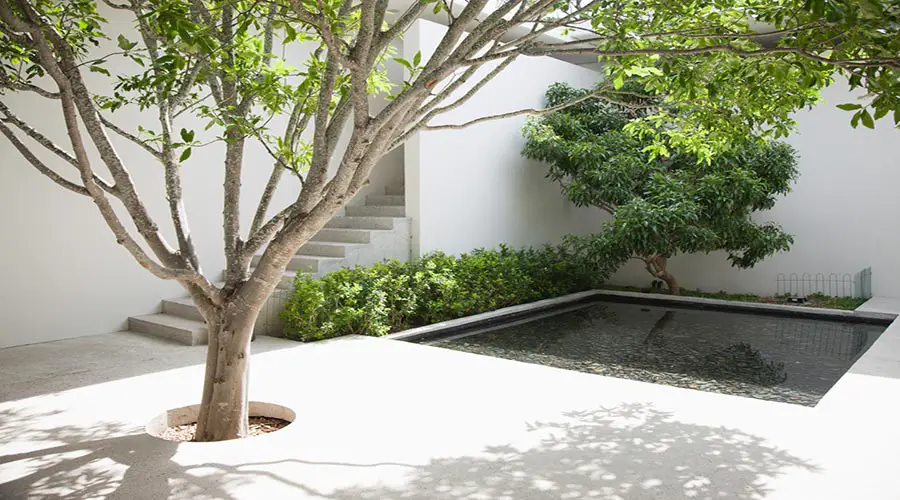
It is not uncommon to find tree roots that grow on the surface rather than downwards, like in a normal situation. Root growth on the surface gets in the way of many projects, and you may find it hard to choose what to do when you need to use the space.
Pouring a concrete patio over tree roots is difficult, but it is not impossible. Because roots need a constant water supply, pouring a concrete patio over tree roots can cause the tree’s death, but it’s not instantaneous or guaranteed. Often, removing large roots will kill off smaller roots.
If you intend to pour a new patio around an existing tree, you’ll need to make provisions to allow space for the tree to grow and receive water. Keep in mind that the concrete will likely crack as the tree matures. Try techniques such as root pruning or root barriers to manage the roots and prevent them from causing problems.
We don’t recommend pouring concrete over tree roots. Tree roots are an integral part of the tree’s overall health and structural integrity; covering them with concrete can cause the tree’s death. The roots may continue to grow and push up against the concrete, causing cracks and other damage to the patio.
What to Consider When Building a Concrete Patio Over Tree Roots
To know if building a patio over tree roots is possible, you must first understand how to prepare the space for a concrete patio.
Paver patio and concrete patio slabs rank high among the available choices as they are the easiest and most efficient.
The advantage of concrete slabs over their counterparts is that it does not make it easy for weeds to sprout through their floor, as it is also easier to maintain.
There are tree roots in spaces where you want to install your new patio becomes a challenging situation because as much as you want to go on with your project, you also want the best for the trees.
Tree roots are the life link of the tree, and when they are brutally handled, the tree’s life is at stake.
The question is, do you chop off the roots, abandon the project, or find a way to go about your project while doing the best you can to ensure the tree survives after all the trauma?
Concrete is a mix of sand and cement, and when mixed in the correct ratios, it produces a challenging mixture that can last long and withstand harsh conditions when laid down.
Will Pouring Concrete Patio Over Tree Roots Kill Them?
The roots of the tree supply the water and nutrients necessary to survive.
Will pouring a concrete patio over tree roots survive with a concrete slab sitting on top of them? The truth is that the tree’s root system gets caught in the crossfire and, if not careful, will suffocate of lack of air to breathe.
Whether tree roots survive or not under concrete largely depends on groundwater sources under the concrete and if the roots extend out past the concrete.
Will concrete hurt tree roots?
Yes, the concrete slab will hurt the tree roots in two ways:
- A concrete patio will cut off the usual supply of air and water, which the roots are accustomed to and which is beneficial to the life and growth of the tree. We eat to live, goes the slogan.
- A concrete patio is heavy and all it comes with. The roots that were once free are now burdened with the weight of the concrete slab. Roots are accustomed to growing where it is accessible to penetrate, but they will be affected already.
Note: Unless the tree has other sufficient roots from the surrounding circumference (the patio project does not impact that) to supply it with food and water, the tree will stagnate in growth and might eventually give up on life.
The good news is that tree roots extend in all directions. The more room they colonize, the greater the tree’s chances of thriving in every sector, height, or diameter.
How the Ground Under a Patio is Prepared (A Rough Picture)
A concrete contractor often pours concrete patio spaces between 4 and 8 inches deep. The surrounding soil must be cleared of debris, grass, and soil, ensuring the surface is as flat as possible.
There are two ways of excavating the soil from the designated area in a typical situation;
- Manually digging up the area and shoving the soil into a wheelbarrow, either carried out on your own or by a hired hand.
- Letting an excavating machine do the work, most of these machines are hired because many of the people who have them are involved in excavation work.
But now that your project is intruding in the way of tree roots, you must do the manual mode at a slower pace, having enough patience and being mindful of the roots.
Even so, some roots will not escape unhurt or displaced. To minimize damage, whoever is responsible might have to use gloves when cleaning and excavating soil, as tools like shovels will hurt the roots.
The truth is that the whole process will be painful, slow, and time-consuming.
It is one thing to suffocate the tree roots and another to hurt them. Tree roots consist of secondary roots, a network of smaller sources diverting from the main legume to speed up the search for water and nutrients.
Given all that, it will be outrageous to be not mindful of them intentionally.
How big is the patio? With this in mind, the project starts with marking out the boundaries the patio is set to cover, excavating and leveling up the area, constructing a four-wall unit that will hold the concrete, dividing up the inner space, and finally pouring concrete on it.
But before concrete is poured to cover the base of the patio area entirely, gravel or more giant stones that have been crushed are laid on the bottom; this is for two reasons;
- It is to level out the surface below so it will not consume too much concrete.
- To allow the concrete to drain off the water.
The idea of paving the patio base with gravel or crushed stone is the break we have been looking for all along. It is the proverbial “casting one stone to kill two birds.”
When patio creators think of ways to ensure that the patio survives all weather and nature-related challenges, they solve significant issues, especially tree roots covered in concrete problems.
Two things in this scenario kill tree roots;
- Lack of water
- Stagnant water is not draining away
The primary purpose of laying gravel on the patio base is to allow water to drain so that concrete does not break or sink.
As that happens, the tree’s roots benefit as they still breathe and get supplied with water draining from the concrete.
It is a genius idea and a win-win situation for everyone.
Will Concrete Over Roots Kill a Tree?
Trees need food and water, while roots need to breathe to grow and be competent in their activity. The focus is on the soil maintaining air spaces to allow roots to breathe.
That aside, we see big trees daily in towns and cities along boulevards, sidewalks, and footpaths thriving amidst concrete pavements.
How is that possible? The trees in urban settings that continue to grow unabated have root barriers installed adequately around the tree’s stem.
A tree barrier is sensitive enough not to infringe on the tree’s growth and needs. Pouring concrete near a tree and not around a tree will not kill if done right.
Trees die all the time, especially when they lack water, but if they are left with enough room and their water supply is not interrupted, a tree can survive anywhere.
Trees don’t die quickly; they fight a good fight and maximize all they have and the little they get. Here is how trees in towns and cities survive.
In a typical scenario, tree roots travel downwards for food and water. Still, once in a while, we see tree roots protruding and growing on the surface around the tree. Whatever they seek is abundant on the surface than deep down the earth.
In urban areas, tree root barriers work miracles. The idea is to deter the roots from breaking through the concrete surface but still get to breathe and feed.
Just like in patios, footpaths and pavements are shallow. The depth of an 8″ in most patios, while the root barrier goes down 18″.
The thing is that the tree’s stem is given an allowance of 12″ on both sides. It allows the roots and the stem to breathe and enable the roots to take in water.
After the 18″ depth, the roots are set free and can now set their course. It is not the best scenario, but it is better than nothing.
Pouring concrete near a tree will affect it one way or the other, but the chances of it killing the tree are slim.
Can Tree Roots Cause Concrete Damage?
Tree roots under concrete sidewalk slabs, patios, and slab homes can become destructive and costly to repair. Often, thicker concrete pours are reinforced with a wire mesh or rebar grid to strengthen and prevent foundation problems.
But it again depends on the type of tree that is growing near a concrete slab. If the tree belongs to a smaller species, its roots pose no danger. However, more enormous trees have more extensive roots that would defer structures to get their way.
When laying slabs over tree roots, consider the following:
- When was the concrete slab installed?
- Was it when the tree was younger?
- Consider the tree species and the mature size it will become.
But tree roots rarely break through the surface of a compact concrete foundation unless the slab was broken or cracked already. Cracked concrete allows water to reach the soil. When existing trees have roots under the concrete slab, they will find an avenue to break through in the pursuit of water.
But as the tree grows, its root network expands, trailing behind larger and stronger roots. As they expand in size, they demand more space to occupy, and they end up pushing away the soil to make more room.
Heaving occurs when the large tree roots and surrounding ground rise, pushing the concrete upward. The uneven concrete slabs can become a dangerous tripping hazard.
The tree’s survival and steady growth depend on the further the roots can spread and explore. The bigger the sources, the stronger the tree.
But the vigorous growth of tree roots can be disastrous to concrete floors and slabs. Because trees can not break through a barrier, they tend to manor our—the bend where the end of a concrete floor or slab could suffer the consequences.
The roots will exert pressure as they grow in length and size, and the once comfortable curve is now squeezed. The corner of the concrete pad will lift.
How to Keep Tree Roots from Breaking Concrete Patios
If you want to avoid the roots of trees damaging concrete, you can take several approaches:
Do Annual Tree Root Pruning
Using a root saw or pruning shears, we can cut away problem-causing roots every few years to hold them under control and preclude any potential damage.
Use of Root Barriers Between Trees and Concrete
Protecting your trees is simple with the installation of root barriers. Available in various materials, such as metal or plastic, these tree root barriers are an inexpensive technique to keep roots from expanding and causing destruction to nearby surfaces.
Consider Relocating Trees Near Concrete
If the tree has caused significant damage to your concrete, it may be necessary to reposition it somewhere else where its roots won’t be a problem. To ensure that this doesn’t happen again, make sure you find an appropriate venue for replanting.
Grinding the Tree Stumps and Roots
Unfortunately, sometimes tree removal is necessary. When other approaches fail, it may be essential to utilize a stump grinder to grind away the remaining tree stump and roots. Though this can require considerable effort and capital investment, this is the only feasible solution in some scenarios.
Remember that tree roots are essential for the well-being of your tree, and they should only be disturbed or severed when it is absolutely necessary. Thus, before attempting any root management strategies, seek advice from a local arborist or qualified landscaper.
Pouring Concrete Slab Over Tree Roots FAQs
How far should concrete be from trees?
When planting trees, consider the size of the mature tree’s canopy. We recommend a radius of the tree canopy. For example, for a tree with a 20-foot canopy, you should plant a tree 10 feet from nearby concrete structures. For existing large trees, you can also measure from the base of the tree’s trunk to the shadow of the canopy of the tree.
Can tree roots grow through concrete?
Tree roots can grow through small cracks or openings in concrete, but penetrating solid, undamaged concrete is generally tricky. However, if the concrete is already damaged or has gaps that can allow water to reach the soil, tree roots may be able to grow through it more easily.
What are the best trees to plant near a patio or concrete area?
When planting a tree near a concrete patio, select tree species with shallow root systems. Some good options include Japanese maples, dogwoods, and crepe myrtles. It is also a good idea to avoid planting large trees that have deep roots, such as live oak, willows, ash, or poplars.
For best results, consult a certified arborist or other tree care professional before planting any trees in your yard.
Final Thought
Building a concrete patio over tree roots is difficult, but it is not impossible.
More often than not, the only time the roots of a tree come to your mind is when they are growing on the surface and standing in the way of construction projects such as patios. You want to build a deck for your home, but you find the space allotted has tree roots scavenging on the surface.
It is a tough decision because the roots and the tree will get hurt one way or the other. But to beat the odds, laying clean gravel beneath the concrete slab will solve more than the lack of water.
When you have a pool of water staying in one place for too long, it risks sealing or occupying the air spaces in the soil, suffocating the roots; when the surface of a project can drain water, it becomes a big win for sources as they will be able to breathe.


